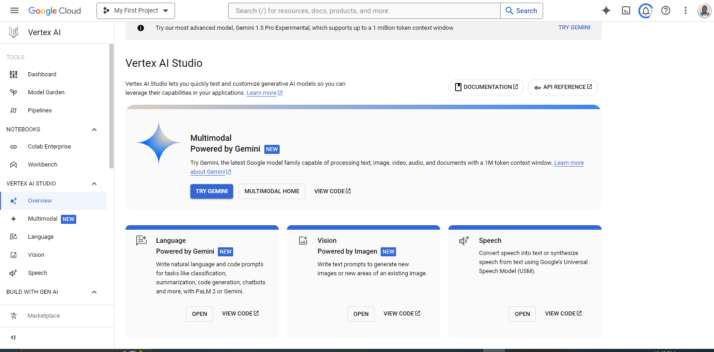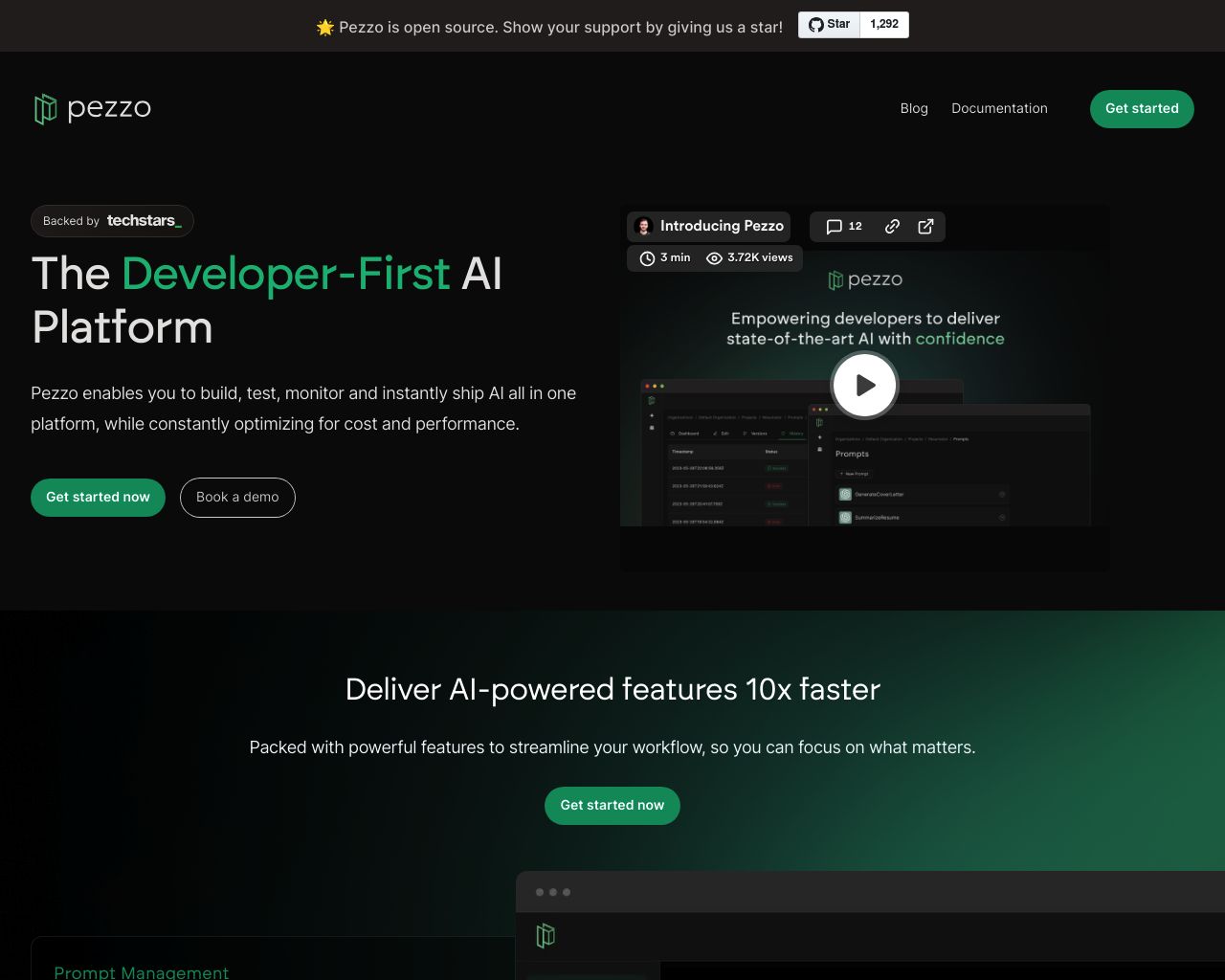Vertex AI vs. Pezzo: Comparing Enterprise ML and Prompt Management
AI development platforms have become essential tools for businesses seeking to harness the power of artificial intelligence. This comparison explores Vertex AI, Google’s comprehensive machine learning platform, and Pezzo, an open-source toolkit for streamlining AI development. We’ll examine how these platforms tackle different aspects of the AI lifecycle, from model training and deployment to prompt engineering and management. Our analysis also introduces SmythOS, a versatile alternative that combines the strengths of both platforms while addressing their limitations. By evaluating key features, usability, and target audiences, this review equips developers, business leaders, and AI enthusiasts with the insights needed to choose the right AI development solution for their specific needs.
Vertex AI Overview
Vertex AI delivers a comprehensive machine learning platform for training and deploying AI models at scale. Google’s powerful infrastructure supports the entire ML lifecycle, from data preparation to model deployment and monitoring.


Screenshot from Vertex AI studio.
Vertex AI shines in enterprise environments, offering robust tools for data scientists and ML engineers. Its standout features include the Gemini multimodal AI model, which handles text, images, audio, and video inputs. The platform also provides a Model Garden for discovering and customizing various AI models, including Google’s proprietary offerings and select open-source options.
Vertex AI delivers a comprehensive machine learning platform for training and deploying AI models at scale. Google’s powerful infrastructure supports the entire ML lifecycle…
While Vertex AI excels in scalability and integration with Google Cloud services, it requires significant technical expertise. The lack of a true no-code editor may limit accessibility for non-technical users. However, for organizations with the necessary skills, Vertex AI offers powerful capabilities like advanced model customization, MLOps tools, and specialized models for tasks like text-to-image generation and healthcare applications.
Vertex AI’s strengths in data management, model training, and deployment make it a formidable choice for enterprises seeking to leverage AI at scale. Its integration with Google Cloud Platform provides a seamless experience for organizations already invested in the Google ecosystem. However, the learning curve and resource requirements may pose challenges for smaller teams or those new to machine learning.
Pezzo Overview
Pezzo empowers developers to streamline AI development with its open-source toolkit. The platform revolutionizes prompt design, management, and collaboration, enabling teams to deliver AI solutions faster and more efficiently.


Pezzo’s standout features include effortless prompt and version management, allowing developers to handle multiple AI prompts and versions with ease. This capability significantly accelerates the development and deployment of AI solutions. The platform also offers powerful A/B testing and experimentation tools, enabling users to optimize their AI models for improved performance and conversion rates.
Pezzo’s standout features include effortless prompt and version management, allowing developers to handle multiple AI prompts and versions with ease.
Cost optimization is another key benefit of Pezzo. The platform provides tools to maximize efficiency in AI operations, potentially reducing costs by up to 50%. This feature is particularly valuable for businesses looking to scale their AI initiatives while maintaining budget control.
Pezzo excels in providing comprehensive troubleshooting capabilities. With features like execution history, time-travel debugging, and test suites, developers can deploy AI models with confidence. The platform’s focus on collaboration and transparency is evident in its detailed observability into AI operations, reducing debugging time and helping teams understand exactly what happened, when, and where.
While Pezzo offers a robust set of features, it may require some technical expertise to fully leverage its capabilities. The platform’s open-source nature provides flexibility but might necessitate more hands-on management compared to fully managed solutions. As with any development tool, users should consider their team’s technical proficiency and project requirements when evaluating Pezzo against other AI agent builders.
Feature Comparison
Vertex AI and Pezzo offer distinct approaches to AI development, each with its own strengths and limitations. Vertex AI excels in enterprise-grade machine learning capabilities, providing a comprehensive platform for the entire ML lifecycle. It supports advanced features like multimodal AI models, MLOps tools, and specialized models for tasks like text-to-image generation. Pezzo, on the other hand, focuses on streamlining prompt engineering and management for AI applications.
A key difference lies in their core components. Vertex AI offers a robust Model Garden with access to Google’s proprietary models and select open-source options, enabling advanced model customization and deployment. Pezzo lacks this extensive model library, instead concentrating on prompt management and version control for existing AI models. This gap in model variety and customization options may limit Pezzo’s applicability for complex machine learning tasks compared to Vertex AI.
In terms of security, both platforms prioritize data protection, but Vertex AI’s integration with Google Cloud Platform provides a more comprehensive security infrastructure. It offers advanced features like Vertex Explainable AI for transparency and detailed access controls. While Pezzo includes security measures, it may not match the enterprise-level security options provided by Vertex AI, potentially making it less suitable for organizations with stringent data protection requirements.
We offer a unique combination of features that address the limitations of both Vertex AI and Pezzo. Our platform provides an intuitive drag-and-drop interface for building AI workflows, similar to Pezzo’s user-friendly approach, while also offering advanced AI model integration and customization capabilities akin to Vertex AI. Additionally, we excel in multi-agent collaboration and autonomous agent deployment, areas where both Vertex AI and Pezzo have limitations. Our platform’s ability to seamlessly integrate various AI models, APIs, and data sources, coupled with robust security features and scalability, positions us as a comprehensive solution that bridges the gaps between enterprise-grade ML platforms and streamlined AI development tools.
Feature Comparison Table
| Vertex AI | Pezzo | SmythOS | |
|---|---|---|---|
| CORE FEATURES | |||
| Hosted Agents (Dev, Production) | ✅ | ❌ | ✅ |
| Visual Builder | ✅ | ❌ | ✅ |
| No-Code Options | ❌ | ❌ | ✅ |
| Memory & Context | ✅ | ❌ | ✅ |
| Autonomous Agents | ✅ | ❌ | ✅ |
| Audit Logs for Analytics | ❌ | ✅ | ✅ |
| SECURITY | |||
| Constrained Alignment | ✅ | ❌ | ✅ |
| IP Control | ✅ | ❌ | ✅ |
| COMPONENTS | |||
| Huggingface AIs | ❌ | ✅ | ✅ |
| Zapier APIs | ❌ | ✅ | ✅ |
| Data Lakes | ✅ | ❌ | ✅ |
| DEPLOYMENT OPTIONS (EMBODIMENTS) | |||
| Deploy as Scheduled Agent | ✅ | ❌ | ✅ |
| DATA LAKE SUPPORT | |||
| Hosted Vector Database | ✅ | ❌ | ✅ |
| Sitemap Crawler | ❌ | ❌ | ✅ |
| YouTube Transcript Crawler | ❌ | ❌ | ✅ |
Best Alternative to Vertex AI and Pezzo
SmythOS emerges as the superior alternative to Vertex AI and Pezzo, offering a comprehensive platform for AI agent development and deployment. We combine the best aspects of both competitors while addressing their limitations, providing users with a powerful, flexible, and user-friendly solution for creating AI-powered applications.
Our drag-and-drop interface surpasses Pezzo’s prompt management focus, allowing users to build complex AI workflows without extensive coding knowledge. This visual approach democratizes AI development, making it accessible to a broader audience while still offering the advanced capabilities that Vertex AI users expect.
SmythOS emerges as the superior alternative to Vertex AI and Pezzo, offering a comprehensive platform for AI agent development and deployment.
Unlike Vertex AI’s complex enterprise-focused platform, SmythOS strikes a balance between powerful features and ease of use. We support a wide range of AI models, including integrations with Hugging Face and other providers, giving users more flexibility than Vertex AI’s Google-centric approach. Our platform also excels in multi-agent collaboration and autonomous agent deployment, areas where both Vertex AI and Pezzo fall short.
SmythOS addresses the security concerns present in both competing platforms. We offer enterprise-grade security features, including data encryption, OAuth integration, and IP control, ensuring that your AI applications meet stringent data protection requirements. This comprehensive security approach makes SmythOS suitable for organizations of all sizes, from startups to large enterprises.
Our platform’s scalability and extensive integration capabilities set us apart from both Vertex AI and Pezzo. SmythOS seamlessly connects with various data sources, APIs, and tools, allowing users to create AI solutions that fit seamlessly into existing workflows. This flexibility, combined with our robust hosting options and deployment choices, enables users to build and scale AI applications more efficiently than ever before.
Conclusion
Vertex AI, Pezzo, and SmythOS each offer unique approaches to AI development and deployment. Vertex AI excels in enterprise-grade machine learning with its comprehensive platform and advanced features like the Gemini multimodal AI model. Pezzo streamlines prompt engineering and management, focusing on efficiency and collaboration for AI applications.
While Vertex AI provides robust tools for data scientists and ML engineers, its complexity may pose challenges for non-technical users. Pezzo offers a more accessible approach but may lack the extensive model customization options of Vertex AI. Both platforms have their strengths, but also limitations in certain areas.
SmythOS emerges as a powerful alternative that addresses the shortcomings of both Vertex AI and Pezzo. Our platform combines an intuitive drag-and-drop interface with advanced AI model integration, making it accessible to users of all technical levels. We excel in multi-agent collaboration and autonomous agent deployment, areas where Vertex AI and Pezzo have limitations.
Our comprehensive solution bridges the gap between enterprise-grade ML platforms and streamlined AI development tools. With features like visual workflow building, extensive API integrations, and flexible deployment options, SmythOS empowers users to create and manage AI agents efficiently. We invite you to explore our diverse range of AI-powered agent templates and experience the future of AI development with a free SmythOS account. Discover how SmythOS can revolutionize your AI workflows and drive innovation in your organization.
Last updated:
Disclaimer: The information presented in this article is for general informational purposes only and is provided as is. While we strive to keep the content up-to-date and accurate, we make no representations or warranties of any kind, express or implied, about the completeness, accuracy, reliability, suitability, or availability of the information contained in this article.
Any reliance you place on such information is strictly at your own risk. We reserve the right to make additions, deletions, or modifications to the contents of this article at any time without prior notice.
In no event will we be liable for any loss or damage including without limitation, indirect or consequential loss or damage, or any loss or damage whatsoever arising from loss of data, profits, or any other loss not specified herein arising out of, or in connection with, the use of this article.
Despite our best efforts, this article may contain oversights, errors, or omissions. If you notice any inaccuracies or have concerns about the content, please report them through our content feedback form. Your input helps us maintain the quality and reliability of our information.
